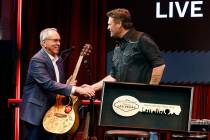With summer stages busy, ‘cultural wasteland’ tag fits no longer
Back in the olden days, the intersection of Rainbow and Charleston boulevards was considered the outskirts of town, Flamingo Road didn’t go over Interstate 15 and Las Vegas had its own “bridge to nowhere.” The ballet, symphony and a handful of theater companies toiled throughout the typical September-through-May season and struggled to survive.
For summer cultural entertainment, one could make the 174-mile trek to Cedar City to attend the Utah Shakespeare Festival, or be satisfied with reruns on our five television stations. Then, in 1976, Super Summer Theatre began performances on 4-by-8-foot platforms, supported by concrete blocks, in a large meadow at Spring Mountain Ranch State Park, about 15 miles outside of town. It was a great way to escape the heat, get some fresh air and a culture fix at the same time.
“Cultural Wasteland” may have been a fitting label then. Not anymore.
That handful of companies has grown to 54 at last count, producing more than 150 plays year-round. Who would be crazy enough to try to compete with Super Summer Theatre or the Utah Shakespeare Festival? The change began slowly, long before television dumped repeats for new programming, when Las Vegas Little Theatre secured its own space and needed to sustain cash flow to pay the rent. As new venues opened, the rate of shows increased.
For companies with their own performance spaces, that seems to be the driving force.
“If we are not producing, we’re losing money,” says Brandon Burk, artistic director of the Onyx Theatre.
But, beyond that, “it allows us to offer great shows throughout the year,” Las Vegas Little Theatre President Walter Niejadlik says.
He adds that summer provides for plays not always feasible during the season because of turn-around time, or the amount of resources that go into a musical.
Super Summer Theatre is so popular that shows are often sold out early, making productions in town more financially viable for the companies providing an alternative. And it’s not all about the money. Particularly for “nomadic” companies that rent where and when they can gain access. For them, it’s an opportunity. It’s a love of craft.
“I suppose it’s a byproduct of the 24/7 nature of the Strip,” says Lysander Abadia of Poor Richard’s Players. “But we’ve found that locals operate under a different calendar than other markets.”
“Though,” Abadia says, “it may be that audiences will go wherever there’s air conditioning.”
Sarah O’Connell of The Asylum Theatre reports ArtSquare and Onyx Theatres both enable The Asylum to present exciting new works by playwrights from across the country.
“We’re grateful,” she says. But moreover her feeling is, “Engaging theater is always in season!”
It’s a winning combination for the companies. The nomads find room at the venues and the venues get positive cash flow.
But, the real winners are you, the patrons.
No matter what your tastes are in plays, there’s as much variety through the summer months as you’ll find during the typical September through May season; everything from “Who’s Afraid of Virginia Woolf” and “Cabaret” for adults to “Really Rosie” and “The Sound of Music Sing-along” for the family.
However you decide to escape the heat to find some culture — cool meadow or air-conditioned building — our desert is no longer a wasteland.
Paul Atreides is one of the theater critics at the Las Vegas Review-Journal. His column appears on the first Thursday of the month.























